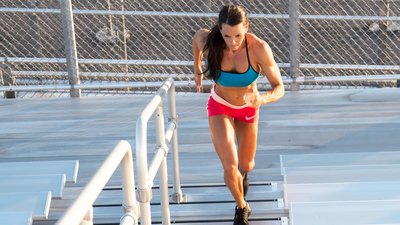have found out that speed is simply inherited. I mean, there are just some individuals who are born to run like a Cheetah. Is it genetics? Most likely, but everyone has some sort of genetic gift or potential. Then how come some of us need to continually work at speed development to obtain that blurring leg spinning power?
There are some coaches who feel, regardless of what they do, they are unable to improve the speed in some of their players. That is, to an extent, true. If you are running a 5.4 second 40 yard dash, you most likely are not going to drop your time down to a 4.5.
Realistically though, it is possible to drop your time four tenths of a second, and in some cases, maybe a dramatic five tenths of a second. Which is a tremendous leap. But, speed drills must be applied to your everyday workouts.
Developing speed is an ongoing process of hard work, dedication, and a whole lot of discipline.
You must work on speed development drills everyday, week after week, and month after month, that's if you want to become faster.
Do not get discouraged or disheartened because of this long course of action.
You will get faster, but you must put forth the effort. Most of us are not gifted, and this type of work ethic sets individuals apart. Those individuals who earn their wings of speed from hard work and dedication are set apart from the rest. To compete, you need speed.
How To Improve Speed
There are two easy ways to improve speed. The first is improving your running mechanics. Most of us run like we're drunk, with hands swinging all over the place, and our feet pounding the ground like we are 600 pound behemoths. So, if you can improve your running technique then you will increase your speed.
The next best way, to improve speed, is to make your legs stronger. Yes, that's right. Crank it up by lifting that iron. The more force you can apply against the ground the faster your legs will run. Trust me, it works. If you work on your parallel squat and hamstring strength you will develop leg power, and that dictates into more speed.
How do I know? Well, from personal experience of course, I acquired a serious leg injury while competing in a powerlifting meet (I tore all four quads and the patella). Approximately six months after the accident, I was able to begin squatting again. My strength increased slowly.
During this time, I was training a young man to get ready for his freshman year of college football, and we had a little race to see who was faster. The 40 yards was counted off and the start given. I ran a 5.1 at 270 pounds. I accomplished this with no running at all, just stretching and performing heavy squats!
Now, if I started developing my running technique, stride length, and stride frequency, I could have possibly dropped my time four tenths of a second, running a 4.8 second 40 yard dash. Oh yeah, I beat that young man by two tenths of a second!
Mass plus acceleration equals power, right? How many times have you seen a game where one team just overpowers the other team for three quarters and then the team you thought was beat turns the game around by driving their opponent into the ground?
It happens alot doesn't it? Perennial powerhouse Nebraska does it all the time. It doesn't matter how big and strong your team is; you will surely loose unless you know how to utilize your speed.
You cannot reach your full speed potential by just running sprints or just working on leg strength either. You must work on both, with a number of other speed training techniques to achieve your top speed development.
TIps And Drills To Improve Speed
Running Technique
- Speed is a product of stride length and stride frequency. Improving your stride length and stride frequency can increase your speed. Stride frequency is the number of steps that you take per second. Stride length is the distance you cover with each step. Some ways to develop these techniques are running up or down hills at 20 to 40 yards long, or running stadium steps in place of hill running.
Arm Swing Drill
Proper arm movement will also do more to improve your sprinting technique more than anything else. The arm swing mirrors the lower body action. If your arm action is not moving right, then you will have leg action problems. Keep your arm length at 90 degree, because if it is more your stride frequency will be cut short, and ultimately your running speed. Your arms should swing up towards your mouth.
Like you're eating an ice cream cone. This keeps the angle of your arms tight. On the back swing drive your arms so that they will rise above the shoulders. This causes the legs to drive harder. Bend slightly at the waist, keep your back straight, and keep your body relaxed.
Hills and Stadium Steps
These drills develop explosiveness and stride length. Concentrate on pushing off the hind leg, extending completely at your ankles, knees, and hips. Hold your arms at a 90-degree angle with a straight swinging motion, like described above in the arm swinging drills.
Run only about 30 to 40 steps and then walk back down to the bottom of the steps were you started and repeat. This drill can be done with a hill, in place of stadium steps. Find a small hill that is about 50 to 100 yards long with a 15 to 20 degree angle.
Actually, hill sprinting is a little better then stadium steps because you jog back down the hill. This will help increase stride length also. Never Sprint down the hill, jog really easy and do not over extend your leg movement. Run back up the hill when you reach the bottom of the hill.
Speed is an essential component to any athletic event. Prior to any speed development workout always perform some form of warm up drills also. Warm-up drills can consist of a jog around the block, or a couple laps around the stadium. Also, include high knee's for about 10 yards, backward run for 10 yards, and do a couple 100 yard stride's.
After completing a warm-up then stretch your hamstrings, quads, calves, and upper torso too. All of these exercises can be added to your workout during or after practice.
How Often
Perform the above exercises about three times a week for a couple months, and then push your running to five days a week. If you are able to work out with a partner then try this quick, easy, and inexpensive way to develop leg speed. Have you ever seen the magazine article or TV commercial featuring the athlete running with a parachute behind them?
If you can afford a parachute then I would advise acquiring one, they are great for speed development. But, if you are like me and cannot afford to purchase one of these devices, then go to your local bicycle shop and get some old bicycle tubes.
Place the tube around your waist, have your partner grab the tube from behind, and then pull slightly, lean forward swinging arms and high knee in a stride motion, for a predetermined distance. When you are comfortable with the motion, then execute full speed sprints with this resistant attached to you.
Rugby is a game that is constantly moving, and speedy players can put several trys in your favor. A scrum that has speed, will be the quickest at the lock-up, thus gaining control of the ball. Speed development should be taken seriously for all players on the rugby field, not just the backs. So, execute the above drills and run faster. It's that easy.



